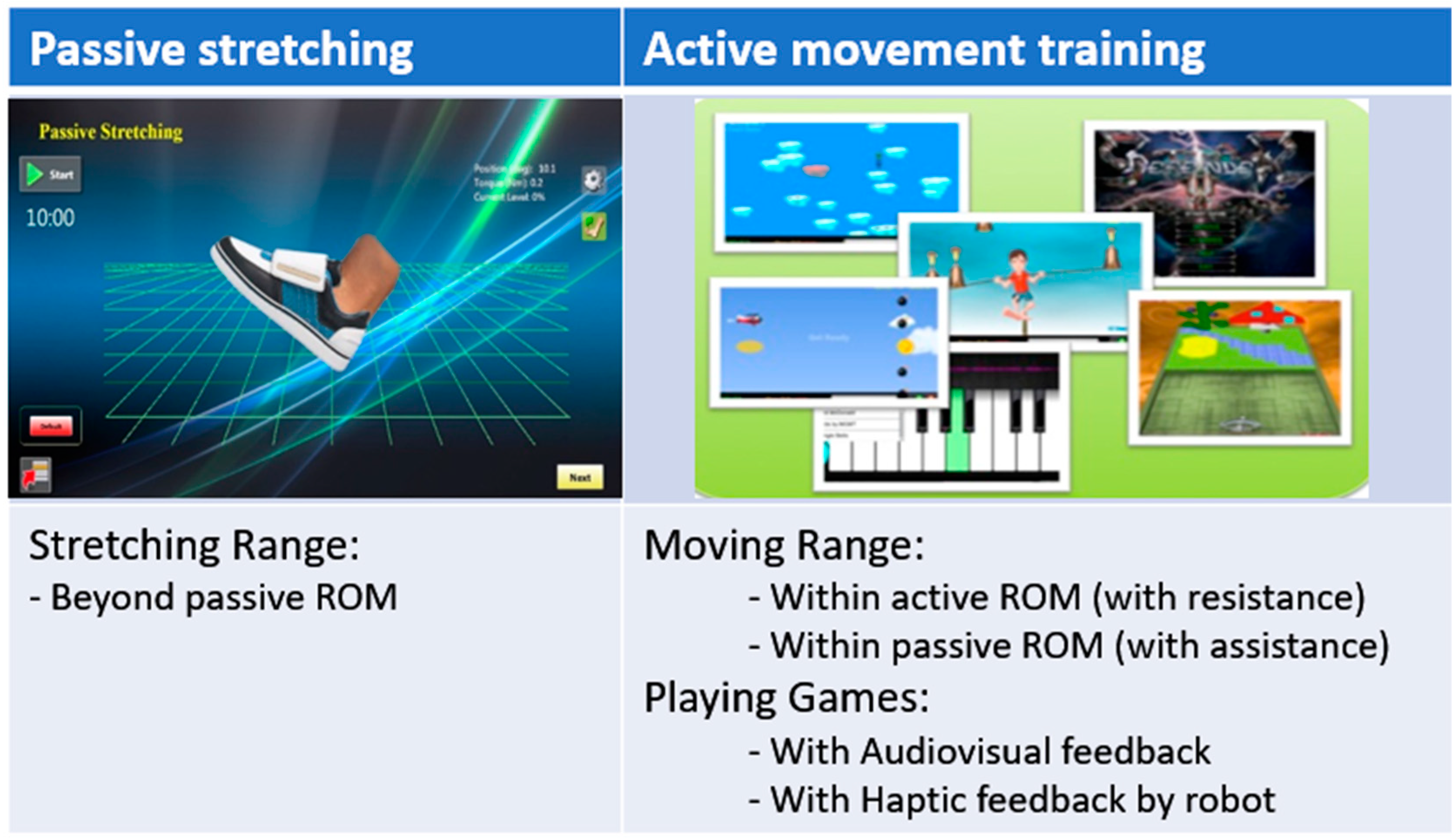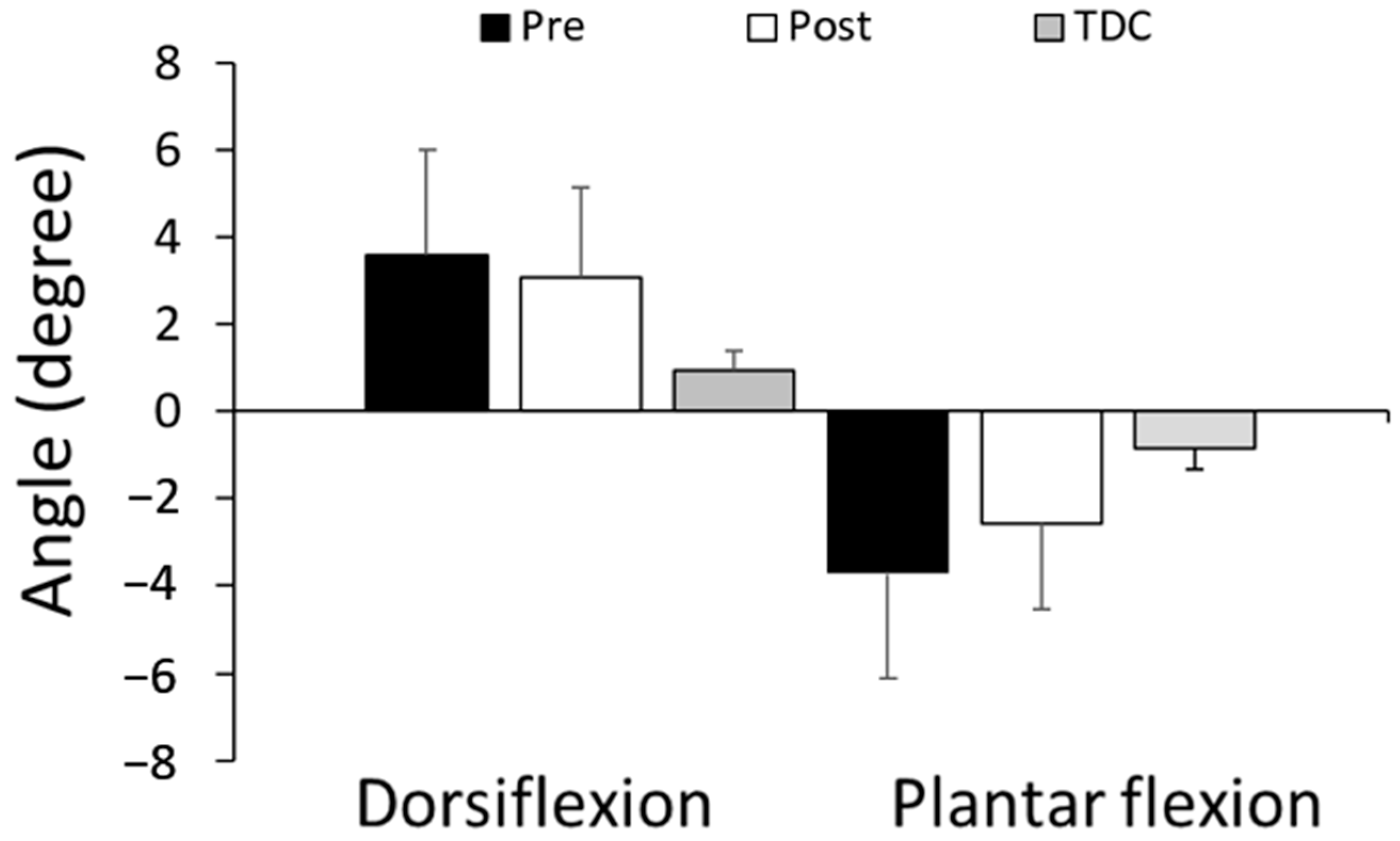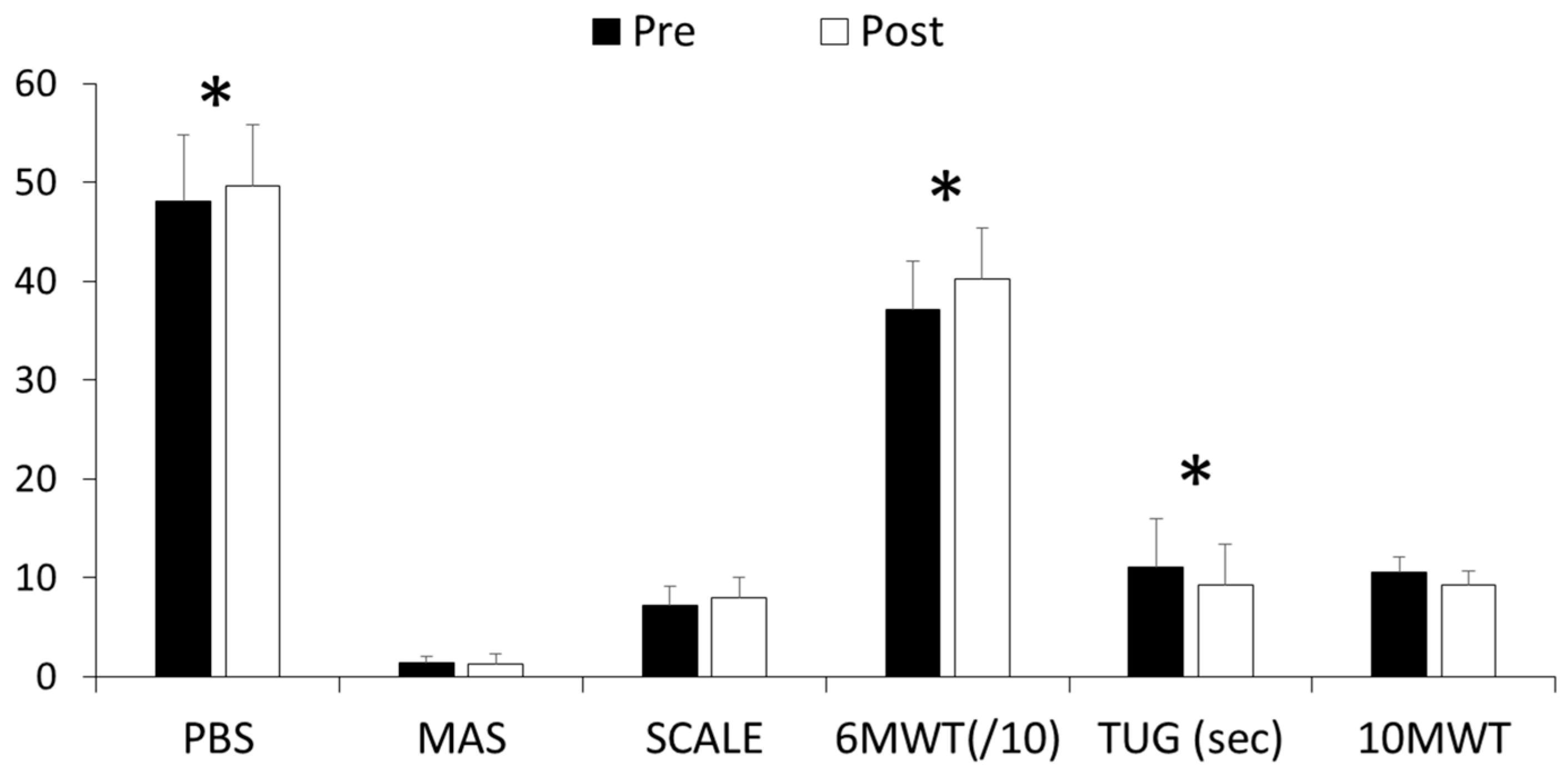Robotic Ankle Training Improves Sensorimotor Functions in Children with Cerebral Palsy—A Pilot Study
Abstract
1. Introduction
2. Materials and Methods
2.1. Participants
2.2. Experimental Training Procedures
2.3. Outcome Measures and Assessments
2.4. Statistical Analysis
3. Results
3.1. Proprioceptive Deficit
3.2. Effect of RAT
4. Discussion
5. Conclusions
Author Contributions
Funding
Institutional Review Board Statement
Informed Consent Statement
Data Availability Statement
Acknowledgments
Conflicts of Interest
References
- Clark, S.L.; Hankins, G.D.V. Temporal and Demographic Trends in Cerebral Palsy—Fact and Fiction. Am. J. Obstet. Gynecol. 2003, 188, 628–633. [Google Scholar] [CrossRef]
- Goldstein, M. A Report: The Definition and Classification of Cerebral Palsy April 2006. Dev. Med. Child Neurol. 2007, 49, 8–14. [Google Scholar] [CrossRef]
- Elder, G.C.; Kirk, J.; Stewart, G.; Cook, K.; Weir, D.; Marshall, A.; Leahey, L. Contributing Factors to Muscle Weakness in Children with Cerebral Palsy. Dev. Med. Child Neurol. 2003, 45, 542–550. [Google Scholar] [CrossRef]
- Gaebler-Spira, D. Overview of Sensorimotor Dysfunction in Cerebral Palsy. Top. Spinal Cord Inj. Rehabil. 2011, 17, 50–53. [Google Scholar] [CrossRef]
- Graham, H.K.; Rosenbaum, P.; Paneth, N.; Dan, B.; Lin, J.-P.; Damiano, D.L.; Becher, J.G.; Gaebler-Spira, D.; Colver, A.; Reddihough, D.S.; et al. Cerebral Palsy. Nat. Rev. Dis. Primer 2016, 2, 15082. [Google Scholar] [CrossRef]
- Ross, S.A.; Engsberg, J.R. Relationships Between Spasticity, Strength, Gait, and the GMFM-66 in Persons With Spastic Diplegia Cerebral Palsy. Arch. Phys. Med. Rehabil. 2007, 88, 1114–1120. [Google Scholar] [CrossRef] [PubMed]
- Degraafpeters, V.; Blauwhospers, C.; Dirks, T.; Bakker, H.; Bos, A.; Haddersalgra, M. Development of Postural Control in Typically Developing Children and Children with Cerebral Palsy: Possibilities for Intervention? Neurosci. Biobehav. Rev. 2007, 31, 1191–1200. [Google Scholar] [CrossRef] [PubMed]
- Sanger, T.D.; Chen, D.; Delgado, M.R.; Gaebler-Spira, D.; Hallett, M.; Mink, J.W. Taskforce on Childhood Motor Disorders Definition and Classification of Negative Motor Signs in Childhood. Pediatrics 2006, 118, 2159–2167. [Google Scholar] [CrossRef] [PubMed]
- Eek, M.N.; Beckung, E. Walking Ability Is Related to Muscle Strength in Children with Cerebral Palsy. Gait Posture 2008, 28, 366–371. [Google Scholar] [CrossRef]
- Hong, W.-H.; Chen, H.-C.; Shen, I.-H.; Chen, C.-Y.; Chen, C.-L.; Chung, C.-Y. Knee Muscle Strength at Varying Angular Velocities and Associations with Gross Motor Function in Ambulatory Children with Cerebral Palsy. Res. Dev. Disabil. 2012, 33, 2308–2316. [Google Scholar] [CrossRef]
- Lee, J.H.; Sung, I.Y.; Yoo, J.Y. Therapeutic Effects of Strengthening Exercise on Gait Function of Cerebral Palsy. Disabil. Rehabil. 2008, 30, 1439–1444. [Google Scholar] [CrossRef] [PubMed]
- Cho, C.; Hwang, W.; Hwang, S.; Chung, Y. Treadmill Training with Virtual Reality Improves Gait, Balance, and Muscle Strength in Children with Cerebral Palsy. Tohoku J. Exp. Med. 2016, 238, 213–218. [Google Scholar] [CrossRef] [PubMed]
- van Vulpen, L.F.; de Groot, S.; Rameckers, E.; Becher, J.G.; Dallmeijer, A.J. Improved Walking Capacity and Muscle Strength After Functional Power-Training in Young Children With Cerebral Palsy. Neurorehabilit. Neural Repair 2017, 31, 827–841. [Google Scholar] [CrossRef] [PubMed]
- Chen, K.; Wu, Y.-N.; Ren, Y.; Liu, L.; Gaebler-Spira, D.; Tankard, K.; Lee, J.; Song, W.; Wang, M.; Zhang, L.-Q. Home-Based Versus Laboratory-Based Robotic Ankle Training for Children With Cerebral Palsy: A Pilot Randomized Comparative Trial. Arch. Phys. Med. Rehabil. 2016, 97, 1237–1243. [Google Scholar] [CrossRef]
- Lee, Y.; Chen, K.; Ren, Y.; Son, J.; Cohen, B.A.; Sliwa, J.A.; Zhang, L.-Q. Robot-Guided Ankle Sensorimotor Rehabilitation of Patients with Multiple Sclerosis. Mult. Scler. Relat. Disord. 2017, 11, 65–70. [Google Scholar] [CrossRef]
- Tsai, L.-C.; Ren, Y.; Gaebler-Spira, D.J.; Revivo, G.A.; Zhang, L.-Q. Effects of an Off-Axis Pivoting Elliptical Training Program on Gait Function in Persons With Spastic Cerebral Palsy: A Preliminary Study. Am. J. Phys. Med. Rehabil. 2017, 96, 515–522. [Google Scholar] [CrossRef] [PubMed]
- Novak, I.; Morgan, C.; Fahey, M.; Finch-Edmondson, M.; Galea, C.; Hines, A.; Langdon, K.; Namara, M.M.; Paton, M.C.; Popat, H.; et al. State of the Evidence Traffic Lights 2019: Systematic Review of Interventions for Preventing and Treating Children with Cerebral Palsy. Curr. Neurol. Neurosci. Rep. 2020, 20, 3. [Google Scholar] [CrossRef]
- Klingels, K.; De Cock, P.; Molenaers, G.; Desloovere, K.; Huenaerts, C.; Jaspers, E.; Feys, H. Upper Limb Motor and Sensory Impairments in Children with Hemiplegic Cerebral Palsy. Can They Be Measured Reliably? Disabil. Rehabil. 2010, 32, 409–416. [Google Scholar] [CrossRef]
- Yekutiel, M.; Jariwala, M.; Stretch, P. Sensory Deficit in the Hands of Children with Cerebral Palsy: A New Look at Assessment and Prevalence. Dev. Med. Child Neurol. 1994, 36, 619–624. [Google Scholar] [CrossRef] [PubMed]
- Pavão, S.L.; Rocha, N.A.C.F. Sensory Processing Disorders in Children with Cerebral Palsy. Infant Behav. Dev. 2017, 46, 1–6. [Google Scholar] [CrossRef]
- Zarkou, A.; Lee, S.C.K.; Prosser, L.; Hwang, S.; Franklin, C.; Jeka, J. Foot and Ankle Somatosensory Deficits in Children with Cerebral Palsy: A Pilot Study. J. Pediatr. Rehabil. Med. 2021, 14, 247–255. [Google Scholar] [CrossRef] [PubMed]
- Goble, D.J.; Hurvitz, E.A.; Brown, S.H. Deficits in the Ability to Use Proprioceptive Feedback in Children with Hemiplegic Cerebral Palsy. Int. J. Rehabil. Res. 2009, 32, 267–269. [Google Scholar] [CrossRef] [PubMed]
- Wingert, J.R.; Burton, H.; Sinclair, R.J.; Brunstrom, J.E.; Damiano, D.L. Joint-Position Sense and Kinesthesia in Cerebral Palsy. Arch. Phys. Med. Rehabil. 2009, 90, 447–453. [Google Scholar] [CrossRef] [PubMed]
- Selles, R.W.; Li, X.; Lin, F.; Chung, S.G.; Roth, E.J.; Zhang, L.-Q. Feedback-Controlled and Programmed Stretching of the Ankle Plantarflexors and Dorsiflexors in Stroke: Effects of a 4-Week Intervention Program. Arch. Phys. Med. Rehabil. 2005, 86, 2330–2336. [Google Scholar] [CrossRef] [PubMed]
- Waldman, G.; Yang, C.-Y.; Ren, Y.; Liu, L.; Guo, X.; Harvey, R.L.; Roth, E.J.; Zhang, L.-Q. Effects of Robot-Guided Passive Stretching and Active Movement Training of Ankle and Mobility Impairments in Stroke. NeuroRehabilitation 2013, 32, 625–634. [Google Scholar] [CrossRef]
- Wu, Y.-N.; Hwang, M.; Ren, Y.; Gaebler-Spira, D.; Zhang, L.-Q. Combined Passive Stretching and Active Movement Rehabilitation of Lower-Limb Impairments in Children With Cerebral Palsy Using a Portable Robot. Neurorehabil. Neural Repair 2011, 25, 378–385. [Google Scholar] [CrossRef] [PubMed]
- Franjoine, M.R.; Gunther, J.S.; Taylor, M.J. Pediatric Balance Scale: A Modified Version of the Berg Balance Scale for the School-Age Child with Mild to Moderate Motor Impairment. Pediatr. Phys. Ther. Off. Publ. Sect. Pediatr. Am. Phys. Ther. Assoc. 2003, 15, 114–128. [Google Scholar] [CrossRef] [PubMed]
- Bohannon, R.W.; Smith, M.B. Interrater Reliability of a Modified Ashworth Scale of Muscle Spasticity. Phys. Ther. 1987, 67, 206–207. [Google Scholar] [CrossRef] [PubMed]
- Fowler, E.G.; Staudt, L.A.; Greenberg, M.B.; Oppenheim, W.L. Selective Control Assessment of the Lower Extremity (SCALE): Development, Validation, and Interrater Reliability of a Clinical Tool for Patients with Cerebral Palsy. Dev. Med. Child Neurol. 2009, 51, 607–614. [Google Scholar] [CrossRef] [PubMed]
- Kaufman, M.; Moyer, D.; Norton, J. The Significant Change for the Timed 25-Foot Walk in the Multiple Sclerosis Functional Composite. Mult. Scler. J. 2000, 6, 286–290. [Google Scholar] [CrossRef]
- Gorter, J.W.; Rosenbaum, P.L.; Hanna, S.E.; Palisano, R.J.; Bartlett, D.J.; Russell, D.J.; Walter, S.D.; Raina, P.; Galuppi, B.E.; Wood, E. Limb Distribution, Motor Impairment, and Functional Classification of Cerebral Palsy. Dev. Med. Child Neurol. 2004, 46, 461–467. [Google Scholar] [CrossRef]
- Barati, A.A.; Rajabi, R.; Shahrbanian, S.; Sedighi, M. Investigation of the Effect of Sensorimotor Exercises on Proprioceptive Perceptions among Children with Spastic Hemiplegic Cerebral Palsy. J. Hand Ther. 2020, 3, 411–417. [Google Scholar] [CrossRef]
- Zarkou, A.; Lee, S.C.K.; Prosser, L.A.; Jeka, J.J. Foot and Ankle Somatosensory Deficits Affect Balance and Motor Function in Children With Cerebral Palsy. Front. Hum. Neurosci. 2020, 14, 45. [Google Scholar] [CrossRef]
- Bartonek, A.; Lidbeck, C.M.; Gutierrez-Farewik, E.M. Influence of External Visual Focus on Gait in Children With Bilateral Cerebral Palsy. Pediatr. Phys. Ther. 2016, 28, 393–399. [Google Scholar] [CrossRef] [PubMed]
- Steele, K.M.; Seth, A.; Hicks, J.L.; Schwartz, M.S.; Delp, S.L. Muscle Contributions to Support and Progression during Single-Limb Stance in Crouch Gait. J. Biomech. 2010, 43, 2099–2105. [Google Scholar] [CrossRef] [PubMed]
- Kalkman, B.M.; Holmes, G.; Bar-On, L.; Maganaris, C.N.; Barton, G.J.; Bass, A.; Wright, D.M.; Walton, R.; O’Brien, T.D. Resistance Training Combined With Stretching Increases Tendon Stiffness and Is More Effective Than Stretching Alone in Children With Cerebral Palsy: A Randomized Controlled Trial. Front. Pediatr. 2019, 7, 333. [Google Scholar] [CrossRef]
- Hösl, M.; Böhm, H.; Eck, J.; Döderlein, L.; Arampatzis, A. Effects of Backward-Downhill Treadmill Training versus Manual Static Plantarflexor Stretching on Muscle-Joint Pathology and Function in Children with Spastic Cerebral Palsy. Gait Posture 2018, 65, 121–128. [Google Scholar] [CrossRef]
- Craig, J.; Hilderman, C.; Wilson, G.; Misovic, R. Effectiveness of Stretch Interventions for Children With Neuromuscular Disabilities: Evidence-Based Recommendations. Pediatr. Phys. Ther. 2016, 28, 262–275. [Google Scholar] [CrossRef] [PubMed]
- Kalkman, B.M.; Bar-On, L.; O’Brien, T.D.; Maganaris, C.N. Stretching Interventions in Children With Cerebral Palsy: Why Are They Ineffective in Improving Muscle Function and How Can We Better Their Outcome? Front. Physiol. 2020, 11, 131. [Google Scholar] [CrossRef] [PubMed]





| ID | Gender | Age (Years) | Height (m) | Weight (kg) | Training Side | GMFCS | Topographical Classification |
|---|---|---|---|---|---|---|---|
| 1 | M | 8 | 1.38 | 33.3 | Right | I | Hemiplegia |
| 2 | F | 6 | 1.16 | 16.3 | Right | II | Diplegia |
| 3 | F | 11 | 1.35 | 30.4 | Right | I | Hemiplegia |
| 4 | F | 12 | 1.47 | 36.9 | Right | I | Diplegia |
| 5 | M | 5 | 1.14 | 21.0 | Right | II | Diplegia |
| 6 | M | 6 | 1.17 | 21.5 | Right | I | Diplegia |
| 7 | F | 10 | 1.45 | 32.5 | Right | III | Diplegia |
| 8 | M | 7 | 1.25 | 26.7 | Right | II | Diplegia |
| 4 boys 4 girls | 8.1 ± 2.6 | 1.29 ± 0.13 | 27.3 ± 7.2 | Right | I (n = 4) II (n = 3) III (n = 1) | Hemi (n = 2) Di (n = 6) |
| Proprioception Test | Children with CP | TDC | |
|---|---|---|---|
| Pre | Post | ||
| Proprioceptive Acuity (deg) | |||
| Dorsiflexion | 3.60 ± 2.38 | 3.08 ± 2.07 | 0.94 ± 0.43 * |
| Plantar flexion | −3.72 ± 2.38 | −2.59 ± 1.94 | −0.86 ± 0.48 * |
| Number of wrong answers | |||
| Dorsiflexion | 0.38 ± 1.06 | 0.25 ± 0.71 | 0.00 ± 0.00 |
| Plantar flexion | 1.00 ± 1.31 | 0.25 ± 0.71 | 0.00 ± 0.00 |
| Outcome Measures | Pre | Post |
|---|---|---|
| PBS (0–56) | 48.14 ± 6.67 | 49.57 ± 6.29 * |
| MAS (0–4) | 1.38 ± 0.69 | 1.21 ± 1.04 |
| SCALE (0–10) | 7.14 ± 1.95 | 8.00 ± 2.00 |
| TUG (sec) | 11.08 ± 4.91 | 9.30 ± 4.14 * |
| 6 MWT (m) | 371.76 ± 4.91 | 402.72 ± 5.10 * |
| 10 MWT (sec) | 10.56 ± 1.59 | 9.21 ± 1.48 |
Disclaimer/Publisher’s Note: The statements, opinions and data contained in all publications are solely those of the individual author(s) and contributor(s) and not of MDPI and/or the editor(s). MDPI and/or the editor(s) disclaim responsibility for any injury to people or property resulting from any ideas, methods, instructions or products referred to in the content. |
© 2023 by the authors. Licensee MDPI, Basel, Switzerland. This article is an open access article distributed under the terms and conditions of the Creative Commons Attribution (CC BY) license (https://creativecommons.org/licenses/by/4.0/).
Share and Cite
Lee, Y.; Gaebler-Spira, D.; Zhang, L.-Q. Robotic Ankle Training Improves Sensorimotor Functions in Children with Cerebral Palsy—A Pilot Study. J. Clin. Med. 2023, 12, 1475. https://doi.org/10.3390/jcm12041475
Lee Y, Gaebler-Spira D, Zhang L-Q. Robotic Ankle Training Improves Sensorimotor Functions in Children with Cerebral Palsy—A Pilot Study. Journal of Clinical Medicine. 2023; 12(4):1475. https://doi.org/10.3390/jcm12041475
Chicago/Turabian StyleLee, Yunju, Deborah Gaebler-Spira, and Li-Qun Zhang. 2023. "Robotic Ankle Training Improves Sensorimotor Functions in Children with Cerebral Palsy—A Pilot Study" Journal of Clinical Medicine 12, no. 4: 1475. https://doi.org/10.3390/jcm12041475
APA StyleLee, Y., Gaebler-Spira, D., & Zhang, L.-Q. (2023). Robotic Ankle Training Improves Sensorimotor Functions in Children with Cerebral Palsy—A Pilot Study. Journal of Clinical Medicine, 12(4), 1475. https://doi.org/10.3390/jcm12041475







